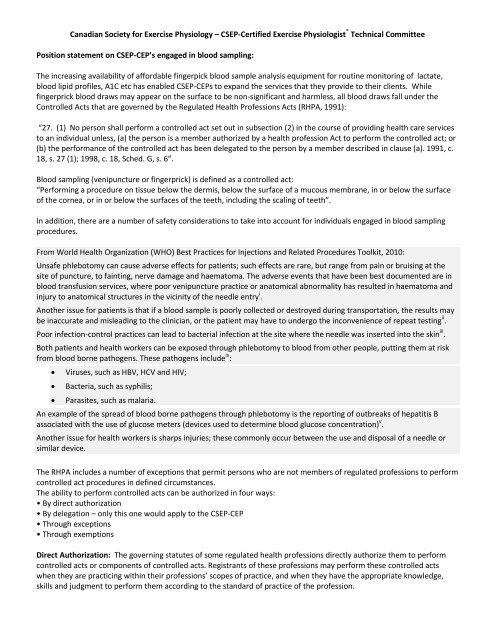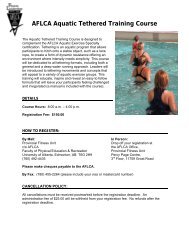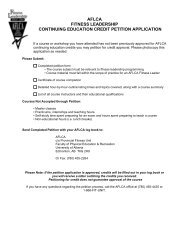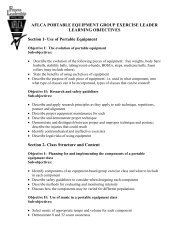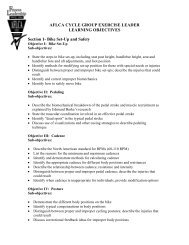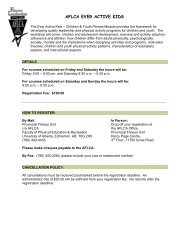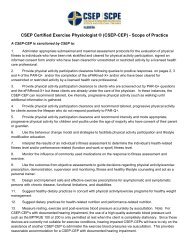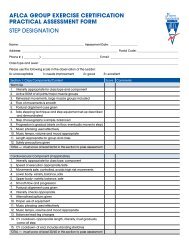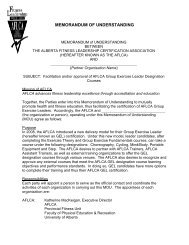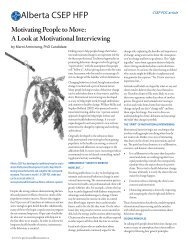Canadian Society for Exercise Physiology â CSEP-Certified ...
Canadian Society for Exercise Physiology â CSEP-Certified ...
Canadian Society for Exercise Physiology â CSEP-Certified ...
Create successful ePaper yourself
Turn your PDF publications into a flip-book with our unique Google optimized e-Paper software.
<strong>Canadian</strong> <strong>Society</strong> <strong>for</strong> <strong>Exercise</strong> <strong>Physiology</strong> – <strong>CSEP</strong>-<strong>Certified</strong> <strong>Exercise</strong> Physiologist ® Technical Committee<br />
Position statement on <strong>CSEP</strong>-CEP’s engaged in blood sampling:<br />
The increasing availability of af<strong>for</strong>dable fingerpick blood sample analysis equipment <strong>for</strong> routine monitoring of lactate,<br />
blood lipid profiles, A1C etc has enabled <strong>CSEP</strong>-CEPs to expand the services that they provide to their clients. While<br />
fingerprick blood draws may appear on the surface to be non-significant and harmless, all blood draws fall under the<br />
Controlled Acts that are governed by the Regulated Health Professions Acts (RHPA, 1991):<br />
“27. (1) No person shall per<strong>for</strong>m a controlled act set out in subsection (2) in the course of providing health care services<br />
to an individual unless, (a) the person is a member authorized by a health profession Act to per<strong>for</strong>m the controlled act; or<br />
(b) the per<strong>for</strong>mance of the controlled act has been delegated to the person by a member described in clause (a). 1991, c.<br />
18, s. 27 (1); 1998, c. 18, Sched. G, s. 6”.<br />
Blood sampling (venipuncture or fingerprick) is defined as a controlled act:<br />
“Per<strong>for</strong>ming a procedure on tissue below the dermis, below the surface of a mucous membrane, in or below the surface<br />
of the cornea, or in or below the surfaces of the teeth, including the scaling of teeth”.<br />
In addition, there are a number of safety considerations to take into account <strong>for</strong> individuals engaged in blood sampling<br />
procedures.<br />
From World Health Organization (WHO) Best Practices <strong>for</strong> Injections and Related Procedures Toolkit, 2010:<br />
Unsafe phlebotomy can cause adverse effects <strong>for</strong> patients; such effects are rare, but range from pain or bruising at the<br />
site of puncture, to fainting, nerve damage and haematoma. The adverse events that have been best documented are in<br />
blood transfusion services, where poor venipuncture practice or anatomical abnormality has resulted in haematoma and<br />
injury to anatomical structures in the vicinity of the needle entry i .<br />
Another issue <strong>for</strong> patients is that if a blood sample is poorly collected or destroyed during transportation, the results may<br />
be inaccurate and misleading to the clinician, or the patient may have to undergo the inconvenience of repeat testing ii .<br />
Poor infection-control practices can lead to bacterial infection at the site where the needle was inserted into the skin iii .<br />
Both patients and health workers can be exposed through phlebotomy to blood from other people, putting them at risk<br />
from blood borne pathogens. These pathogens include iv :<br />
<br />
<br />
<br />
Viruses, such as HBV, HCV and HIV;<br />
Bacteria, such as syphilis;<br />
Parasites, such as malaria.<br />
An example of the spread of blood borne pathogens through phlebotomy is the reporting of outbreaks of hepatitis B<br />
associated with the use of glucose meters (devices used to determine blood glucose concentration) v .<br />
Another issue <strong>for</strong> health workers is sharps injuries; these commonly occur between the use and disposal of a needle or<br />
similar device.<br />
The RHPA includes a number of exceptions that permit persons who are not members of regulated professions to per<strong>for</strong>m<br />
controlled act procedures in defined circumstances.<br />
The ability to per<strong>for</strong>m controlled acts can be authorized in four ways:<br />
• By direct authorization<br />
• By delegation – only this one would apply to the <strong>CSEP</strong>-CEP<br />
• Through exceptions<br />
• Through exemptions<br />
Direct Authorization: The governing statutes of some regulated health professions directly authorize them to per<strong>for</strong>m<br />
controlled acts or components of controlled acts. Registrants of these professions may per<strong>for</strong>m these controlled acts<br />
when they are practicing within their professions’ scopes of practice, and when they have the appropriate knowledge,<br />
skills and judgment to per<strong>for</strong>m them according to the standard of practice of the profession.
Delegation or Medical Directive: Delegation or medical directive is the process by which a person who is member of a<br />
regulated health profession that has controlled acts authorized to it delegates the authority to per<strong>for</strong>m one or more of<br />
these controlled acts or components of controlled acts to another person, who is then authorized to per<strong>for</strong>m these acts.<br />
Delegation or Medical Directives must be:<br />
given in advance by physicians/ordering authorizers to enable an implementer to decide to per<strong>for</strong>m the ordered<br />
procedure(s) under specific conditions without a direct assessment by the physician or authorizer at the time.<br />
written and have essential components.<br />
See the appendix <strong>for</strong> a copy of a sample Medical Directive and/or Delegation Template.<br />
Exception<br />
Exceptions are circumstances, defined in law, where the restrictions on per<strong>for</strong>ming controlled acts do not apply (e.g. in an<br />
emergency).<br />
Exemptions<br />
Exemptions are controlled acts, or components of controlled acts, that are exempted from the per<strong>for</strong>mance restrictions<br />
on these acts. The current exemptions <strong>for</strong> controlled acts are contained in a regulation made under the authority of the<br />
RHPA.<br />
Other<br />
The taking of a blood sample from a vein or by pricking the skin is exempt from subsection 27 (1) of the Act if the person<br />
taking the blood sample is employed by a laboratory or specimen collection centre licensed under the Laboratory and<br />
Specimen Collection Centre Licensing Act. Most <strong>CSEP</strong>-CEPs are not working in these licensed laboratories.<br />
<strong>CSEP</strong>-CEP’s that wish to engage in blood sampling procedures are required to:<br />
Achieve competence and obtain certification through examination and demonstration of hands-on ability to<br />
per<strong>for</strong>m the act competently.<br />
Provide documentation annually, at the time of their <strong>CSEP</strong>-CEP renewal, of their certification and the<br />
authorization to per<strong>for</strong>m the act from the “delegator” specifying the range of clients and conditions under which<br />
the act can be per<strong>for</strong>med.<br />
Have their blood sampling competence be re-certified annually to ensure continued competence.<br />
Those members who do not obtain the appropriate training, certification (and/or recertification) and the requisite<br />
authorization from a delegator are not be permitted to carry out blood sampling procedures; failure to obtain the<br />
appropriate training, certification (and/or recertification) and the requisite authorization from a delegator voids insurance<br />
coverage <strong>for</strong> this service.
i Galena H. Complications occurring from diagnostic venepuncture. Journal of Family Practice, 1992, 34(5):582–584.<br />
ii So you’re going to collect a blood specimen: an introduction to phlebotomy. USA, College of American Pathologists, 2007.<br />
iii World Health Organization et al. Do no harm: injection safety in the context of infection prevention. Washington, DC, John Snow Inc, 2005.<br />
iv Wilburn S, Eijkemans G. Protecting health workers from occupational exposure to HIV, hepatitis, and other bloodborne pathogens: from<br />
research to practice. Asian-Pacific Newsletter on Occupational Health and Safety, 2007, 13:8–12.<br />
Prüss-Üstün A, Rapitil E, Hutin Y. Introduction and methods: assessing the environmental burden of disease at national and local levels.<br />
Geneva, World Health Organization, 2003.<br />
Centers <strong>for</strong> Disease Control and Prevention. A comprehensive immunization strategy to eliminate transmission of hepatitis B virus infection in<br />
the United States: Recommendations of the Advisory Committee on Immunization Practices (ACIP) Part II: Immunization of adults. Morbidity<br />
and Mortality Weekly Report, 2006, 55(No. RR–16):1–25.<br />
Centers <strong>for</strong> Disease Control and Prevention. Updated US Public Health Service guidelines <strong>for</strong> the management of occupational exposures to<br />
HBV, HCV, and HIV and recommendations <strong>for</strong> post exposure prophylaxis. Morbidity and Mortality Weekly Report, 2001, 50(No. RR–11):21–23.<br />
http://www.cdc.gov/MMWR/preview/MMWRhtml/rr5011a1.htm<br />
Beltrami EM et al. Transmission of HIV and hepatitis C virus from a nursing home patient to a health care worker. American Journal of<br />
Infection Control, 2003, 31(3):168–175.<br />
Hauri AM, Armstrong GL, Hutin YJ. The global burden of disease attributable to contaminated injections given in health care settings.<br />
International Journal of STD & AIDS, 2004, 15(1):7–16.<br />
Perry J, Jagger J. EPINet data report: injuries from phlebotomy needles. Advances in Exposure Prevention, 2003, 6(4):43–45.<br />
v Transmission of hepatitis B virus among persons undergoing blood glucose monitoring in long-term care facilities – Mississippi, North<br />
Carolina and Los Angeles County, Cali<strong>for</strong>nia, 2003–2004. Morbidity and Mortality Weekly Report, 2004, 54:220–223.<br />
Dreesman JM et al. Outbreak of hepatitis B in a nursing home associated with capillary blood sampling. Epidemiology and Infection, 2006,<br />
134(5):1102–1113.


